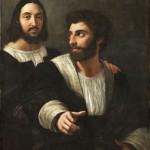 The Afterlife of Raphael: The Artist as Paradigm and Symbol
The Afterlife of Raphael: The Artist as Paradigm and Symbol
Posted By Stefano de Bosio, Sunday, May 18, 2014
The figure of Raphael stands as a paradigm in early modern art. Generations of artists, theorists and amateurs looked avidly at his life and works, establishing through them the theoretical and conceptual framework of their own life, works and interests. To borrow the words used by Martin Rosenberg in his 1995 book on the reception of Raphael in early modern France, Raphael rapidly became a « paradigm and symbol » to be copied and emulated, a sort of visible archetype of the ideal artist. A number of influential artists, including Parmigianino and Guido Reni, Annibale Carracci and Anton Raphael Mengs, Nicolas Poussin and J.-A. Dominique Ingres, consciously forged their career in order to become, or to be considered as the new Raphael of their generation. In this process, somewhat similar to the creation of a religious hagiography, new and different identities were set up, in part as a result of new ideas about the historical evolution of art, in part beyond any concern for truth and historical validation.
Taking these assumptions as a point of departure, this panel aims to explore and investigate the artistic and cultural legacy of Raphael, in particular by tracing and measuring the impact and the influence of this « mythical » model on the way artists fashioned their own life, work and profession, but also on subsequent art theory. We invite papers focusing on the role and meaning of Raphael as an archetype and a source of inspiration as well as addressing the multifaceted persistence of his myth over time and space in early modern Europe. Possible topics include, but are not limited to, the role and influence of Raphael as:
-the exemplary coordinator of a vast artistic workshop, thanks to his design skills;
-the perfect courtier, epitomizing the relationship between artist and patrons;
-the experimenter of the potentiality of new mediums (print etc.)
-the source of an ideal classicism, able to create a long-lasting stylistic model;
-the new Apelles, who syntethised the classical heritage.
We would further expect analysis and exploration of the « Nachleben » of his material heritage, including for example the appropriations of his works and possessions (drawings, houses, etc.), and the worship of his relics and historical remains.
Interested participants should send a 150-words proposal, keywords and short CV to Mattia Biffis, Center for Advanced Study in the Visual Arts – Washington (m-biffis@nga.gov), Stefano de Bosio, Deutsches Forum fùr Kunstgeschichte – Paris (sdebosio@dt-forum.org), Marzia Faietti, Gabinetto dei Disegni e delle Stampe degli Uffizi – Firenze (faietti@polomuseale.firenze.it), by June 8, 2014.

Leave a Reply
You must be logged in to post a comment.